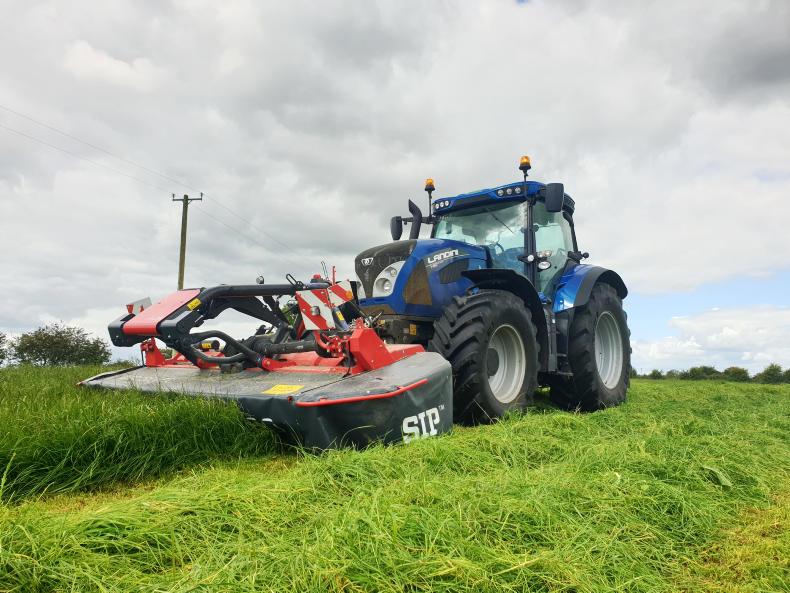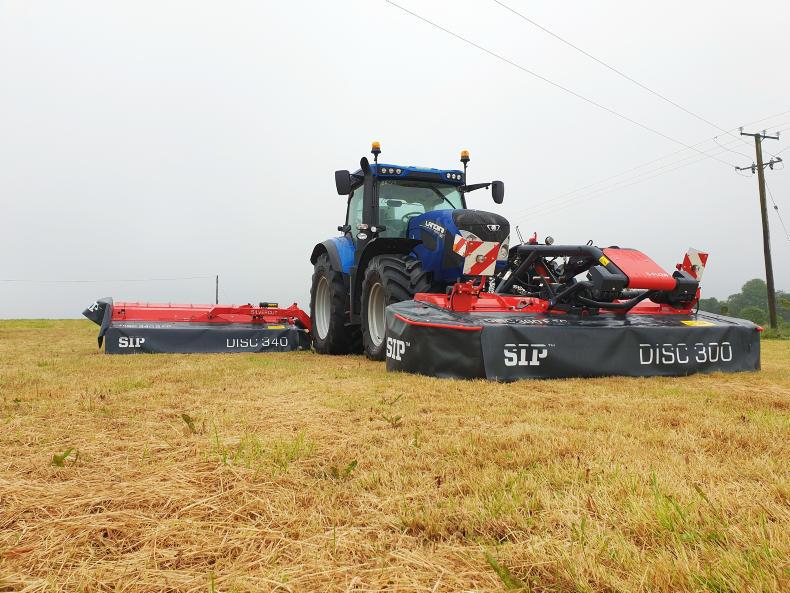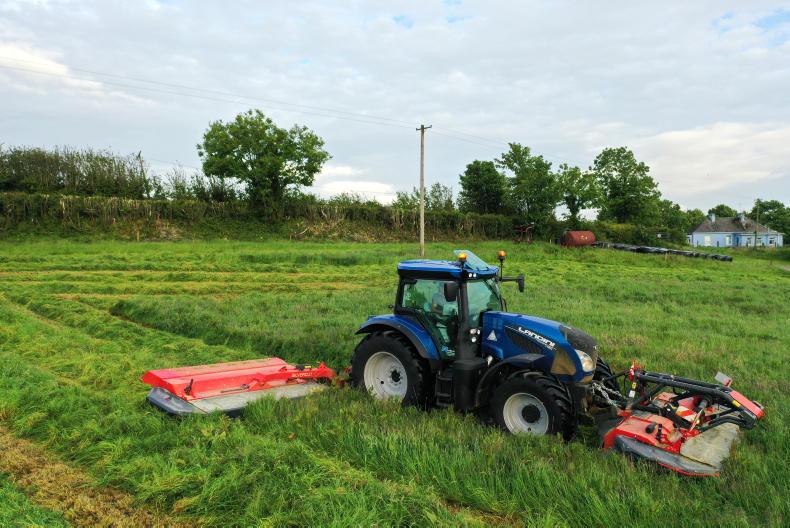Based in Slovenia, SIP has only recently appeared on the radar of Irish farmers. They were introduced into Ireland in 2016, when Meath based machinery importer, Farmec, first showcased them to the Irish public at the FTMTA Grass and Muck exhibition at Gurteen Agricultural College.
Watch: New kid on the block has the cutting edge.
Despite being relatively new to Ireland, SIP has been manufacturing farm machinery for over 60 years. The company has manufactured implements such as rakes, forage wagons and tedders for companies Krone, Pöttinger and Claas, among many others. In fact, SIP claim to have been the first company to develop a twin rotor rake. Today, it exports over 80% of its production to 55 countries worldwide.
The front mower was fitted with a seven disc cutterbed, while the rear mounted mower was fitted with an eight disc cutterbed.
What better way to get to know about SIP machines than to put them to work? Farmec kindly gave us a front and rear mounted mower combination to try out in the peak of the silage cutting season. We decided to try out the duo in the west of Ireland, an area that many manufacturers believe has some of the toughest testing grounds in the world.
First thoughts
At a first glance the mowers seem to be well finished. One of the biggest issues that farmers and contractors have when it comes to rear mounted mowers is weight. But in fairness to SIP, they seem have got it spot on. The rear mounted conditioner mower we tested was the Silvercut Disc 340 S FC. It weighs in at just 1,180kg. 
Meanwhile, the front mower, the Silvercut Disc 300 F, is also very light, weighing in at just 1,006kg. The ground following ability of the front mower was a stand out feature. SIP also use many reputable components in their mowers, including SKF bearings and Walterscheid drive-line components.
Cutterbar
SIP designs and manufactures its own cutterbar. The front mower was fitted with a seven disc cutterbed, while the rear mounted mower was fitted with an eight disc cutterbed. The two outside discs on each bed rotate clockwise towards the centre. The discs are manufactured from 4mm Hardox steel.

Each disc is equipped with an overload safety protection system, consisting of an intermediate flange with four brass shear pins. If the disc comes into contact with a foreign object and overloads, these shear pins will break to protect the bed. Although we never ran into this kind of trouble when using the mowers, SIP says that these pins are very easy to replace. This is a similar system used by many mower manufacturers. Each disc is mounted to the cutterbar through a double closed bearing.
The cutterbar had SIP’s quick fit blade changing system. After operating mowers where I would have to get the ratchet and spanner out to change blades, the quick fit system was a treat and I would never go back.
The big stand out feature for me on the cutterbar was the durability of the cutting blades. During our trial, we cut in excess of 300ac. After cutting this acreage, the blades still showed a full edge all the way around. I have never seen cutting blades keep an edge like them.
Conditioner
Both the front and rear mowers are equipped with plastic finger conditioners. SIP don’t offer the option of a steel tine conditioner, as it would increase the overall weight of the mowers.

All SIP mowers are fitted with plastic finger conditioners.
Like the majority of conditioner mowers on today’s market, the SIP mowers have the option of adjusting the conditioning intensity.
One thing I liked about the conditioner set-up was its simplicity. Occasionally when mowing, mowers may pick up wire. Mower operators will be well aware of the struggle of removing wire if it gets tangled in around a conditioner bearing. However, the straightforwardness of the SIP conditioner set-up means it’s very easy to access any part of the conditioner and the outer bearings.
Ground following
The ground following ability of the front mower was second to none. The system is known as S-Flow linkage and is based on the design of the mower mounting. Although it appears a little bulky, I found the system to be very responsive in undulating terrain. It combines the hydro-pneumatic suspension, which means consistent ground pressure is maintained.
When mowing uphill, the cutterbar inclines up to +14°, and when mowing downhill the cutterbar inclines down to -6°. The maximum vertical travel of the cutterbar is from -200mm up to +300mm. The rear mower has a relatively good ground following ability and the arm mounting allowed for central pivoting of the cutterbar. The mower was capable of altering the cutting angle by -15° and +20°.
Based in Slovenia, SIP has only recently appeared on the radar of Irish farmers. They were introduced into Ireland in 2016, when Meath based machinery importer, Farmec, first showcased them to the Irish public at the FTMTA Grass and Muck exhibition at Gurteen Agricultural College.
Watch: New kid on the block has the cutting edge.
Despite being relatively new to Ireland, SIP has been manufacturing farm machinery for over 60 years. The company has manufactured implements such as rakes, forage wagons and tedders for companies Krone, Pöttinger and Claas, among many others. In fact, SIP claim to have been the first company to develop a twin rotor rake. Today, it exports over 80% of its production to 55 countries worldwide.
The front mower was fitted with a seven disc cutterbed, while the rear mounted mower was fitted with an eight disc cutterbed.
What better way to get to know about SIP machines than to put them to work? Farmec kindly gave us a front and rear mounted mower combination to try out in the peak of the silage cutting season. We decided to try out the duo in the west of Ireland, an area that many manufacturers believe has some of the toughest testing grounds in the world.
First thoughts
At a first glance the mowers seem to be well finished. One of the biggest issues that farmers and contractors have when it comes to rear mounted mowers is weight. But in fairness to SIP, they seem have got it spot on. The rear mounted conditioner mower we tested was the Silvercut Disc 340 S FC. It weighs in at just 1,180kg. 
Meanwhile, the front mower, the Silvercut Disc 300 F, is also very light, weighing in at just 1,006kg. The ground following ability of the front mower was a stand out feature. SIP also use many reputable components in their mowers, including SKF bearings and Walterscheid drive-line components.
Cutterbar
SIP designs and manufactures its own cutterbar. The front mower was fitted with a seven disc cutterbed, while the rear mounted mower was fitted with an eight disc cutterbed. The two outside discs on each bed rotate clockwise towards the centre. The discs are manufactured from 4mm Hardox steel.

Each disc is equipped with an overload safety protection system, consisting of an intermediate flange with four brass shear pins. If the disc comes into contact with a foreign object and overloads, these shear pins will break to protect the bed. Although we never ran into this kind of trouble when using the mowers, SIP says that these pins are very easy to replace. This is a similar system used by many mower manufacturers. Each disc is mounted to the cutterbar through a double closed bearing.
The cutterbar had SIP’s quick fit blade changing system. After operating mowers where I would have to get the ratchet and spanner out to change blades, the quick fit system was a treat and I would never go back.
The big stand out feature for me on the cutterbar was the durability of the cutting blades. During our trial, we cut in excess of 300ac. After cutting this acreage, the blades still showed a full edge all the way around. I have never seen cutting blades keep an edge like them.
Conditioner
Both the front and rear mowers are equipped with plastic finger conditioners. SIP don’t offer the option of a steel tine conditioner, as it would increase the overall weight of the mowers.

All SIP mowers are fitted with plastic finger conditioners.
Like the majority of conditioner mowers on today’s market, the SIP mowers have the option of adjusting the conditioning intensity.
One thing I liked about the conditioner set-up was its simplicity. Occasionally when mowing, mowers may pick up wire. Mower operators will be well aware of the struggle of removing wire if it gets tangled in around a conditioner bearing. However, the straightforwardness of the SIP conditioner set-up means it’s very easy to access any part of the conditioner and the outer bearings.
Ground following
The ground following ability of the front mower was second to none. The system is known as S-Flow linkage and is based on the design of the mower mounting. Although it appears a little bulky, I found the system to be very responsive in undulating terrain. It combines the hydro-pneumatic suspension, which means consistent ground pressure is maintained.
When mowing uphill, the cutterbar inclines up to +14°, and when mowing downhill the cutterbar inclines down to -6°. The maximum vertical travel of the cutterbar is from -200mm up to +300mm. The rear mower has a relatively good ground following ability and the arm mounting allowed for central pivoting of the cutterbar. The mower was capable of altering the cutting angle by -15° and +20°.










 This is a subscriber-only article
This is a subscriber-only article









SHARING OPTIONS: